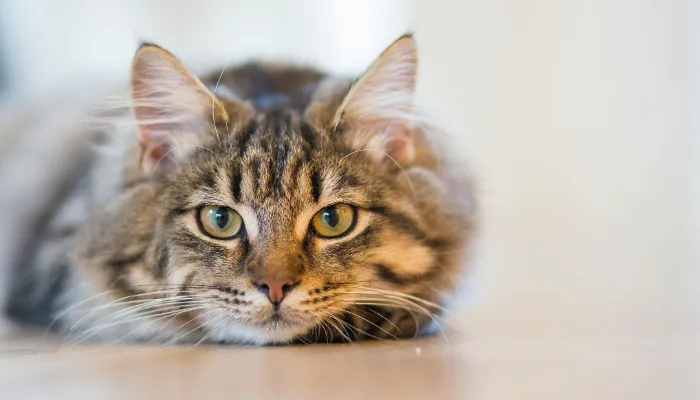Cats have their own ways of communicating that are very different from ours, which is why many of us often question, “how do cats say “No”?” As much as these creatures can’t speak human languages, they have their own ways to convey their feelings.
If you have found yourself pondering, “how do cats say “No”?” or trying to distinguish their unique cues of refusal, worry not. We are here to understand these behaviors in order to make the relationship that you have with your furry friend as smooth as possible. Let’s learn how to be better at being cat translators and with that, figure out how cats communicate “No” differently!

Understanding Cat Body Language
One of the best ways to approach the inquiry, “how do cats say “No”?” is through an analysis of cat body language. While looking at cats, it is hard to figure out exactly what they mean when they want to communicate something because everyone has grown up in a world where words are the main medium of transferring messages, and cats have a completely different approach.
The need to have a voice and to talk to one another is entirely absent in a cat’s world. Discontent is expressed through their body language: the movement of their tail, the posture of their body, and their facial expressions.
Common Signs of “No” Through Body Language
- Tail Flicking: One of the most predominant signals that a cat is agitated or vexed is when they decide to rapidly flick their tails from side to side.
- Ears Back: Another indicator that a cat is saying “No” is when they develop signs of irritation and discomfort by flattening their head against their body.
- Arched Back: An arched back in cats can be aware that other animals are present and will serve as a warning that it does not want to make contact with anyone or anything.
These signals in body language are profound. They are sufficient enough to prove that your cat’s intentions seem disparaging. The next time you ask, “What is the approach that cats take when they do not want something?” therefore, pay attention to their tails as well as their ears.
Vocalization: Cats and Their “No” Sounds
House cats are not known to be the most vocal of companions, but they do possess tones that might embody their version of saying “No.” These were generally quiet, strong, and to-the-point sounds that he offered.
Common Cat Sounds That Say “No”
- Hissing: Hissing is another common way that cats express negative words. Listen for the hissing noise if you find yourself being subjected to a negative situation. It is a quick way for your cat to tell you “No”.
- Slow Growl: Similar to hissing, growling is a form of self-defense. It’s always indicative of some irritation, rage, or often a blunt “No.”
- Chirps or Short Meows: On some occasions, cats may give a faint chirp or a brief meow as an expression of annoyance. While this form of annoyance is definitely softer than hissing, it is still a softer version of “No”.
How do cats say “No”? As stated, hissing and growling are two ways to say “No,” but so are some forms of chirping and meowing. It is also vital to notice how they vocalize, as that may explain how certain the cat is.
Facial Expressions: The Silent “No” in Cats
A kitty’s emotions can be understood through expression. Although cats cannot say “No” using words, they are capable of showing “No.”
Main Facial Features That Hint “No”
- Squinted Eyes: When cats lick their eyes, they communicate a sense of annoyance.
- Dilated Pupils: When a cat’s pupils are wide open, it is associated with fear and anxiety, which would lead to them saying “No” to something.
- Raised Fur: Felines can raise fur along the back when agitated or angry. This is done to signal that they are not happy and want no interaction.
When asking, “how do cats say “No”?”, pay attention to their facial movements. Squinting as well as dilated pupils indicates whether they are in a certain mood or are in discomfort.
Actions That Show “No”
Walking away from a scenario is a way that cats will frequently disengage from a situation. Even though the actions can seem passive-aggressive to most, they are a way of making a statement of ‘No’.
Physical Actions That Could Say ‘No’
- Walking Away: Cats often say ‘No’ by not paying attention, and if your cat walks away when you try to draw their attention, they clearly mean ‘No’.
- Refusing to Eat: Just like humans, cats can also frequently choose to turn away from food when they don’t want to have something.
- Biting or Scratching: Cats can scratch or nip at you when they are being handled too much or in a gentle manner. In any case, it is a means to say ‘No’.
Actions such as these can be viewed as cats rejecting someone or something in a psychological form or a behavioral form. The answer to how do cats say “No”? is quite evident once you observe their actions.
How to Interpret a Cat’s No?
Responding to a cat’s “No” requires understanding how cats express their reluctance. One thing is for sure, if your cat suggests that it is disinterested in something, you need to rescind it.
Guidelines to Aid in Observing Your Cat’s Boundaries
- Allow My Pet Matilda to Cool Off: If your cat is starting to get agitated, most likely they require a break and need some time.
- They Show Clear No, So Do Not Engage: If your cat displays any signs of aggression, do not attempt to engage with them or interact with them in any form.
- Try Not to Miss Out on Snapping My Cat’s Photos at All Times: Always scan for signs of discomfort or any accompanying sounds which could imply they are becoming slowly aware of cats around them.
When you work within the guidelines above, your cat claws on certain boundaries, and thus an increase in comfort and trust is noted over time. It ensures a trustworthy relationship develops with your favorite feline.
Conclusion
As we have seen, answering the difficult and nuanced question, “how do cats say “No”?” involves a myriad of components: the movements of the cat’s body, sounds, and even facial gestures and actions. There is no grandstanding on the fact that while cats do not possess the capability to talk, cats have developed several novel ways to express their emotions.
Be it a blunt hiss or an angry flick of the tail, these actions do tell us that one must be alert so as to respect what the feline boundaries are. One remaining fact alone must capture the essence of this: one does not have to speak to get understood. So the next time you ponder, “How do cats say ‘No’?”, take a moment to analyze the body of the cat and its gestures.
